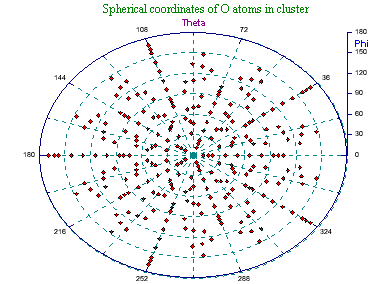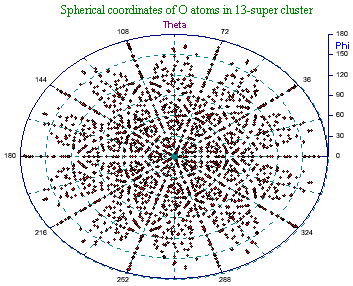
The use of spherical coordinates is nicely applicable to symmetrical systems with molecules positioned on nested concentric spherical surfaces, such as the icosahedral water cluster. In place of the orthogonal x, y, and z coordinates, r, θ (theta), and φ (phi) are used. The symbol r defines the distance from a central origin while θ and φ combine to define the direction. φ is the polar angle (from the z-axis, latitude) and varies from 0° to 180°. θ is the azimuthal angle (in the xy plane, longitude) and ranges between 0° to 360°.*

Figure 1. Spherical coordinates of the water oxygen atoms in icosahedral water clusters (ES). Radial values (r) are given on another page.

Figure 2. Spherical coordinates of the water oxygen atoms in a supercluster of 13 icosahedral water clusters (ES). Radial values (r) are given on another page.
Figure 3. The hydrogen bonding angles of the water molecules in icosahedral water clusters (ES), given as spherical coordinates about their oxygen atoms.
* Conversion between (x, y, z) and (r, θ, φ) coordinate systems:
r = √(x2+y2+z2), θ= arctan(y/x ), φ = arccos(z/r)
if x is positive
and y is positive, 0° ≤ θ ≤ 90°
if x is negative
and y is positive, 90° ≤ θ ≤ 180°
if x is negative
and y is negative, 180° ≤ θ ≤ 270°
if x is positive
and y is negative, 270° ≤ θ ≤ 360°
x = r.cos(θ).sin(φ),
y = r.sin(θ).sin(φ),
z = r.cos(φ)
Home | Site Index | Icosahedral water clusters | Evidence for icosahedral clusters | LSBU | Top
This page was established in 2003 and last updated by Martin Chaplin on 28 October, 2021